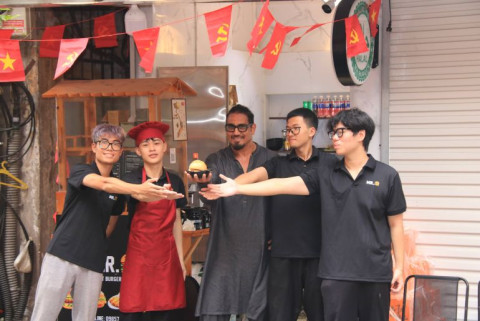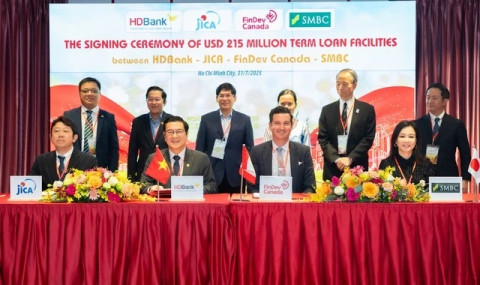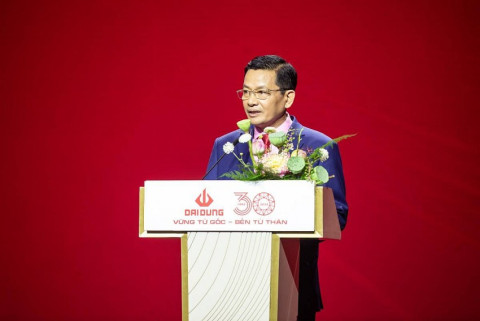Weaving silk from lotus in Vietnam
- 213
- Brand
- 10:15 09/05/2022
DNHN - The fine strands that can be extracted from the delicate lotus flower have the potential to be combined with the silk produced by worms.
On a bright day in a tranquil village by the Day River about 50km from Hanoi, a silkworm workshop is full of life.
Thousands of silkworms are secreting tiny clear thread of silk “working” on a flat mat within wooden frames to make natural silk blankets.
By a window looking over the river, Phan Thi Thuan, the owner of the workshop, is working on an experiment – weaving fabric from "lotus silk". Over her 40 years in the industry, Thuan has become well-known for weaving natural silk into unique blankets.
Carefully holding several lotus stems in her hands, Thuan lays them neatly on her desk.
Using a small knife, she gently makes a cut in each of the stems, which then opens to pull out a small amount of cellulose thread from the cuts. Using water, her skillful fingers arrange the threads, which will be used later to weave lotus "silk" fabric.
“The idea was actually proposed to me by Tran Thi Quoc Khanh, a member of the National Assembly representing Ha Noi,” Thuan told Viet Nam News.
 In this undated photo, Phan Thi Thuan poses for a photo with a scarf made of lotus silk. The scarf has a distinctive lotus scent. (PHOTO / VIET NAM NEWS)
In this undated photo, Phan Thi Thuan poses for a photo with a scarf made of lotus silk. The scarf has a distinctive lotus scent. (PHOTO / VIET NAM NEWS)
Khanh encouraged Thuan to go to Cambodia and Myanmar to learn about weaving "lotus silk", but Thuan insisted she would try it by herself, then go later.
Her village has many lakes and ponds with abundant lotus flowers. Since January 2017, Thuan has tried various ways to extract the most thread from lotus stems.
“The stems from mature lotus flowers offer the strongest and most beautiful thread, but if they are too old the thread is difficult to extract and cut,” she said.
Silk from lotus stems is softer and more flexible than silk from worms. It doesn’t shrink as much as silk from worms, but in my experience, ’lotus silk’ doesn’t last as long
Phan Thi Thuan, Owner of a silkworm workshop
After many failed attempts, Thuan finally succeeded in making a scarf from "lotus silk" with a distinctive scent.
“Silk from lotus stems is softer and more flexible than silk from worms,” she noted. “It doesn’t shrink as much as silk from worms, but in my experience, ’lotus silk’ doesn’t last as long.”
Thuan says that when she puts lotus silk into water, it starts to wrap around her hands.
A silk worm eats mulberry leaves for 20 days, then it secretes silk threads to form a silk nest (cocoon) surrounding its body.
The cocoon should be boiled before the silk is removed for weaving.
“Skilled workers can extract lotus silk from 260 stems per day to produce about 175m of thread,” she said, “Depending on its thickness, a scarf made from ’lotus silk’ requires at least 1,500 stems.”
The intensive labour results in high costs.
“I think if I mix lotus and worm silk, I can produce a new mixed silk for a lower cost that lasts for longer than pure ’lotus silk’,” Thuan said. "But I need more time to confirm that."
“If we had a market for ‘lotus silk’ fabric, it would be easier for me to develop this new kind of "silk" and create more jobs,” Thuan said.
 This undated photo shows silk extracted from lotuses at a silkworm workshop in Hanoi, Vietnam. Skilled workers can get 175m of thread per day. (PHOTO / VIET NAM NEWS)
This undated photo shows silk extracted from lotuses at a silkworm workshop in Hanoi, Vietnam. Skilled workers can get 175m of thread per day. (PHOTO / VIET NAM NEWS)
After she completed her first scarf last year, Thuan took a trip to Cambodia to visit some "lotus silk" workshops.
“I realised that their products were no better than mine,” she said. “I can do better.”
National-level project
Thuan’s project has been adopted by the Ha Noi-based Institute for Ecological Economics under the Union for Science and Technology Associations.
“We proposed the project as a national trial model to produce silk from lotus flowers funded by the State budget for the Council of National Projects,” said Nguyen Duy Chuyen, director of the institute.
Then our experts took a field trip to Myanmar to see how they weave "lotus silk" cloth.
We chose Thuan’s silk workshop in My Duc District as a trial model in the north as she has become an artisan in silk and could quickly find out the best way to get silk from lotus stems, he said.
 This undated photo shows Phan Thi Thuan's workshop in Hanoi, Vietnam, where thousands of silkworms "weave" natural silk blankets by themselves.(PHOTO / VIET NAM NEWS)
This undated photo shows Phan Thi Thuan's workshop in Hanoi, Vietnam, where thousands of silkworms "weave" natural silk blankets by themselves.(PHOTO / VIET NAM NEWS)
According to a research paper by Ha Chu Chu, Nguyen Thi Minh Tam and Dinh Thi Minh from the institute, based on the availability of lotus flowers in Vietnam, the country has great potential for producing "lotus silk".
Their research also found that humidity affects the flexibility of "lotus silk".
'Lotus silk' is as fragile as smoke but it’s quite valuable as it takes so much labour
Phan Thi Thuan
“The research will be useful to adjusting the process of planting lotus and collecting silk from lotus stems,” Chuyen said.
“We will co-operate with the Textile and Garment Institute to research and judge the quality of silk from Vietnamese lotus stems and propose ways to enhance the quality and reduce the cost,” Chuyen said.
Experts will then apply other technology to the weaving and dyeing processes to increase the value of "lotus silk".
Chuyen said next year, the project will move to Dong Thap Muoi (Plain of Reeds in the Mekong Delta), which is home to the largest area of various lotus species in the country.
“'Lotus silk' is as fragile as smoke but it’s quite valuable as it takes so much labour,” Thuan said. “It’s like a gift from Mother Nature.”
“I hope designers will think about using ‘lotus silk’ in high fashion products other than just plain clothes,” she added.
Soucer chinadaily
Related news
- Connecting Leaders, Shaping the Future: Strategic Leadership Planning Meeting – CorporateConnections Hanoi A
- Sunlight - Unilever Vietnam Recognized for Outstanding Contributions to the National Initiative Supporting Women Entrepreneurs
- Deputy Prime Minister Nguyễn Chí Dũng: “The country’s major challenges weigh heavily on my mind — and we must resolve them together.
- Unitsky String Technologies signs cooperation agreements with three Vietnamese partners, opening a new direction for smart mobility and sustainable development
- When artists do business – livelihood is no poetry!
- Before the D‑day to abolish flat‑rate tax: Fear of technology and costs leave small traders struggling to adapt
- Vietnamese enterprises at a crossroads: the impact of a potential US–China deal
- "Digital technicians" must not be forgotten if Vietnam aims to meet its strategic goals
- HDBank: Impressive profit growth, leading in profitability and advancing international integration
- TNI King Coffee sued for over VND 5 Billion in unpaid debts
- VINASME and Jeonnam Technopark Sign MOU on technology cooperation, human resource training, and trade promotion
- Vietnamese entrepreneurs strengthen ASEAN connectivity in the digital iIntegration era
- Prime Minister: Vietnam aims to become a regional logistics hub
- Vietnam upgraded to Secondary Emerging Market by FTSE Russell
- Hanoi’s economy grows 7.92% in first nine months of 2025, FDI surges nearly threefold
- Vietnam’s strong gdp growth fails to ease labor market distress
- US tariffs on Brazil propel Vietnam’s pangasius into global spotlight
- VietLeap AI Accelerator launches: A strategic springboard for Vietnam’s AI startups
- CICON expands strategic alliances: A new step forward in Vietnam–Korea business connectivity
- What must Vietnamese enterprises do to maintain their position in the global supply chain?
Đọc thêm Brand
Hoàng Hải Anh and his young peers launch MR. Burgers – a Halal dining destination in Hanoi
At the age of 18, Hoàng Hải Anh (Haris) and his friends have introduced MR. Burgers, bringing the clean Halal food experience to visitors in Hanoi.
SK Innovation and HD Hyundai (South Korea) step up cooperation with Khánh Hòa Province (Vietnam)
The new cooperation and investment expansion plans of South Korea’s leading conglomerates reaffirm Khánh Hòa’s growing appeal in the eyes of international investors.
A trade fair organizer surprises by joining the ranks of top-earning listed companies
Financial results for Q2 and the first half of 2025 have been announced by numerous companies listed on the Vietnamese stock market.
HDBank secures USD 215 million syndicated loan from JICA, SMBC, and FinDev Canada
HDBank has signed a syndicated loan agreement worth USD 215 million with three international financial institutions: Sumitomo Mitsui Banking Corporation (SMBC), FinDev Canada, and the Japan International Cooperation Agency (JICA).
Sao Mai Group’s pangasius export segment embraces new opportunities
IDI – a member of Sao Mai Group – is building its third factory, aiming to significantly enhance export capacity to capitalize on new opportunities in the U.S. market.
The foundational mark of pioneers in renewable energy amidst an evolving legal framework
Vietnam’s renewable energy journey was marked by bold early investment at a time when the legal framework was still taking shape.
LAMORI – The Spirit of Lam Kinh in Every Breath
LAMORI is more than a luxury retreat—it is a harmonious convergence of boundless nature and sacred historical roots.
The Đại Dũng Group: A 30-Year journey of developing a sustainable value chain
In the context of globalization and sustainable development trends, Đại Dũng Group stands out with its 30-year journey in the fields of mechanical manufacturing, construction, and steel structure.
Rediscovering connection – a journey of discovery at LAMORI
LAMORI Resort & Spa is more than just a retreat; it is a destination for souls seeking reconnection, where every moment brings a meaningful experience.
Southern Vietnamese woman takes Ngoc Linh netted rice paper to all corners of the world
The Cai Be craft village has long been famous for many specialties of the Southern region of Vietnam. However, if it weren't for an unexpected event over 20 years ago, people would not know how Ngoc Linh netted rice paper has spread globally.











